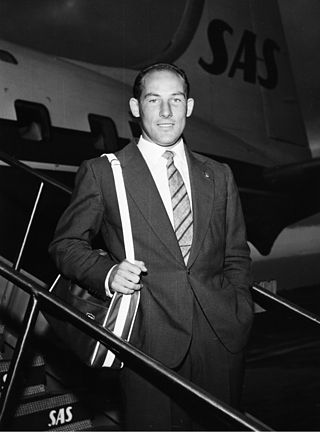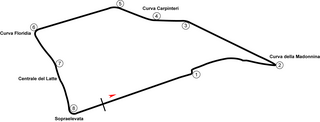
Juan Manuel Fangio, was an Argentine racing driver. He dominated the first decade of Formula One racing, winning the World Drivers' Championship five times.

John Michael Hawthorn was a British racing driver. He became the United Kingdom's first Formula One World Champion driver in 1958, whereupon he announced his retirement, having been profoundly affected by the death of his teammate and friend Peter Collins two months earlier in the 1958 German Grand Prix. He died in a road accident three months after retiring.

Alberto Ascari was an Italian racing driver and a two-time Formula One World Champion. Noted for careful precision and finely-judged accuracy, Ascari was a multitalented racer who competed in motorcycle racing before switching to cars. He won consecutive Formula One world titles in 1952 and 1953 for Scuderia Ferrari, being the team's first World Champion, and the last Italian to win the title as of 2024. This was sandwiched by an appearance in the 1952 Indianapolis 500, and winning the 1954 Mille Miglia.

Sir Stirling Craufurd Moss was a British Formula One driver. An inductee into the International Motorsports Hall of Fame, he won 212 of the 529 races he entered across several different motorsports competitions and has been described as "the greatest driver never to win the Formula One World Championship". In a seven-year span between 1955 and 1961, Moss finished in second place four times and in third place three times.

Emilio Giuseppe "Nino" Farina, often known by the name Giuseppe Antonio Farina, was an Italian racing driver. He was the Italian National Champion in 1937, 1938, and 1939, and in 1950 became the first World Drivers' Champion during the FIA's inaugural season of Formula One.

José Froilán González was an Argentine racing driver, particularly notable for scoring Ferrari's first win in a Formula One World Championship race at the 1951 British Grand Prix. He made his Formula One debut for Scuderia Achille Varzi in the 1950 Monaco Grand Prix. His last Grand Prix was the 1960 Argentine Grand Prix.

The 1956 Argentine Grand Prix was a Formula One motor race held on 22 January 1956 at Buenos Aires. It was race 1 of 8 in the 1956 World Championship of Drivers. With the withdrawal of Mercedes from Formula One, Fangio and Moss would begin the season with new teams. Fangio would join Ferrari while Moss would lead the Maserati team. The grid in Argentina was composed entirely of Italian cars. Ferrari and Maserati showed up with five cars each. The other three cars were also Maseratis: two private entries and Hawthorn for the B.R.M. team.

The 1957 Argentine Grand Prix was a Formula One motor race held on 13 January 1957 at the Buenos Aires circuit. It was race 1 of 8 in the 1957 World Championship of Drivers.

The 1960 Argentine Grand Prix was a Formula One motor race held at Buenos Aires on 7 February 1960. It was race 1 of 10 in the 1960 World Championship of Drivers and race 1 of 9 in the 1960 International Cup for Formula One Manufacturers. This was the last Argentine Grand Prix until 1972, and the last to be held on the No. 4 configuration of the circuit.

The 1974 Argentine Grand Prix was a Formula One motor race held in Buenos Aires on 13 January 1974. It was race 1 of 15 in both the 1974 World Championship of Drivers and the 1974 International Cup for Formula One Manufacturers. The 53-lap race was won by McLaren driver Denny Hulme after he started from tenth position. Niki Lauda finished second for the Ferrari team and his teammate Clay Regazzoni came in third.

The 1980 Argentine Grand Prix was a Formula One motor race held on 13 January 1980 at the Autodromo Municipal Ciudad de Buenos Aires in Argentina. It was the opening round of the 1980 Formula One season. The race was the 16th Argentine Grand Prix and the sixth to be held on the #15 variation of the Buenos Aires circuit. The race was held over 53 laps of the 5.81-kilometre (3.61 mi) circuit for a total race distance of 308 kilometres (191 mi).

The 1997 Argentine Grand Prix was a Formula One motor race held at Autódromo Oscar Alfredo Gálvez in Buenos Aires, Argentina on 13 April 1997. It was the third race of the 1997 Formula One World Championship, and the 600th World Championship Grand Prix.

The Argentine Grand Prix was a round of the Formula One championship, held intermittently from 1953 to 1998, at the Autódromo Oscar y Juan Gálvez in the Argentine national capital of Buenos Aires.

Peter John Collins was a British racing driver. He was killed in the 1958 German Grand Prix, just weeks after winning the RAC British Grand Prix. He started his career as a 17-year-old in 1949, impressing in Formula 3 races, finishing third in the 1951 Autosport National Formula 3 Championship.

Roy Francesco Salvadori was a British racing driver and team manager. He was born in Dovercourt, Essex, to parents of Italian descent. He graduated to Formula One by 1952 and competed regularly until 1962 for a succession of teams including Cooper, Vanwall, BRM, Aston Martin and Connaught. Also a competitor in other formulae, he won the 1959 24 Hours of Le Mans in an Aston Martin with co-driver Carroll Shelby.

Peter Nield Whitehead was a British racing driver. He was born in Menston, Yorkshire and was killed in an accident at Lasalle, France, during the Tour de France endurance race. A cultured, knowledgeable and well-travelled racer, he was excellent in sports cars. He won the 1938 Australian Grand Prix, which along with a 24 Heures du Mans win in 1951, probably was his finest achievement, but he also won two 12 Heures internationales de Reims events. He was a regular entrant, mostly for Peter Walker and Graham Whitehead, his half-brother. His death in 1958 ended a career that started in 1935 – however, he was lucky to survive an air crash in 1948.
Enrico Platé was a motor racing driver and team manager. Although born in Italy, Platé raced, and latterly ran his racing team Scuderia Enrico Platé, under Swiss nationality. He began his career as a mechanic, but swiftly took to racing cars in addition to repairing them. His best result as a driver was fourth place in the 1938 Modena Autodrome. Although he did not achieve any notable success in the pre-World War II voiturette class, Enrico Platé became a significant and influential figure in post-war grand prix and early Formula One racing as a team owner. During his brief career in this role, Platé ran Maseratis for notable drivers such as Prince Bira, Harry Schell and fellow Swiss Toulo de Graffenried.

The Buenos Aires Grand Prix is a motor race held in Buenos Aires, Argentina.

The 1971 Argentine Grand Prix was a motor race consisting of a Formula One class and a Formula 5000 class, held at the Buenos Aires circuit in Buenos Aires on 24 January 1971. The Formula One class was not part of the FIA Formula One World Championship.

The 1956 Syracuse Grand Prix was a motor race, set to Formula One rules, held on 15 April 1956 at the Syracuse Circuit, Sicily. The race was won by Argentinean Juan Manuel Fangio, in his Scuderia Ferrari entered Lancia D50.















